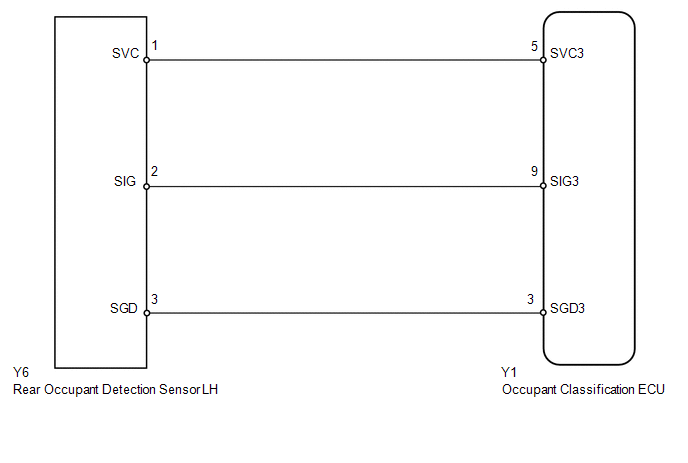DESCRIPTION DTC B1787 is set when the occupant classification ECU receives a collision detection signal, which is sent by the rear occupant detection sensor LH when an accident occurs. DTC B1787 is also set when the front seat frame with adjuster RH is subjected to a strong impact, even if an actual accident has not occurred. However, when the occupant classification ECU outputs a collision detection signal, even if the vehicle is not in a collision, DTC B1787 can be cleared by conducting the zero point calibration and sensitivity check. Therefore, if DTC B1787 is output, first perform the zero point calibration and sensitivity check.
HINT:
WIRING DIAGRAM 
CAUTION / NOTICE / HINT NOTICE:
PROCEDURE
(a) Turn the ignition switch to ON, and wait for at least 60 seconds. (b) Clear any DTCs stored in the center airbag sensor (see page
(c) Turn the ignition switch off. (d) Turn the ignition switch to ON, and wait for at least 60 seconds. (e) Using the Techstream, check for DTCs of the occupant classification ECU (see
page OK: DTC B1787 is not output. HINT: DTCs other than DTC B1787 may be output at this time, but they are not related to this check.
(a) Using the Techstream, perform the zero point calibration (see page
(a) Using the Techstream, perform the sensitivity check (see page
Standard range: 27 to 33 kg (59.5 to 72.8 lb)
(a) Turn the ignition switch to ON, and wait for at least 60 seconds. (b) Clear any DTCs stored in the center airbag sensor (see page
(c) Turn the ignition switch off. (d) Turn the ignition switch to ON, and wait for at least 60 seconds. (e) Using the Techstream, check for DTCs of the occupant classification ECU (see
page OK: DTC B1787 is not output. HINT: DTCs other than DTC B1787 may be output at this time, but they are not related to this check.
(a) Turn the ignition switch off. (b) Disconnect the negative (-) terminal cable from the battery, and wait for at least 90 seconds. (c) Replace the front seat frame with adjuster RH (see page
HINT: Perform the inspection using parts from a normal vehicle when possible.
(a) Connect the negative (-) terminal cable to the battery, and wait for at least 2 seconds. (b) Connect the Techstream to the DLC3. (c) Turn the ignition switch to ON, and wait for at least 60 seconds. (d) Using the Techstream, perform the zero point calibration (see page
(a) Using the Techstream, perform the sensitivity check (see page
Standard range: 27 to 33 kg (59.5 to 72.8 lb)
(a) Turn the ignition switch to ON, and wait for at least 60 seconds. (b) Clear any DTCs stored in the memory (see page
HINT:
(c) Turn the ignition switch off. (d) Turn the ignition switch to ON, and wait for at least 60 seconds. (e) Using the Techstream, check for DTCs of the occupant classification ECU (see
page OK: DTC B1787 is not output. HINT: DTCs other than DTC B1787 may be output at this time, but they are not related to this check.
(a) Turn the ignition switch off. (b) Disconnect the negative (-) terminal cable from the battery, and wait for at least 90 seconds. (c) Replace the occupant classification ECU.
HINT: Perform the inspection using parts from a normal vehicle when possible.
(a) Connect the negative (-) terminal cable to the battery, and wait for at least 2 seconds. (b) Connect the Techstream to the DLC3. (c) Turn the ignition switch to ON, and wait for at least 60 seconds. (d) Using the Techstream, perform the zero point calibration (see page
(a) Using the Techstream, perform the sensitivity check (see page
Standard range: 27 to 33 kg (59.5 to 72.8 lb)
|
Toyota Tundra Service Manual > Sfi System: Throttle Actuator Control System - Stuck Open (P2111,P2112)
DESCRIPTION The throttle actuator is operated by the ECM, and opens and closes the throttle valve using gears. The opening angle of the throttle valve is detected by the Throttle Position (TP) sensor, which is mounted on the throttle with motor body assembly. The TP sensor provides feedback to the E ...